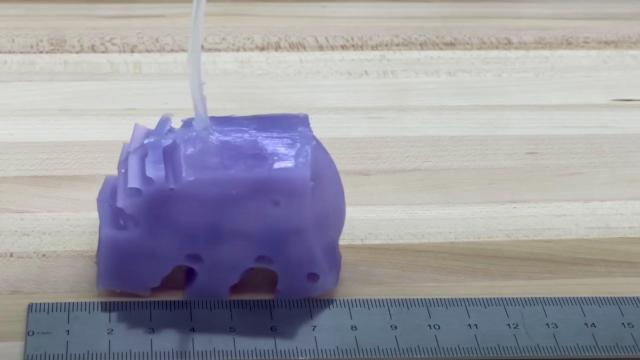It’s become somewhat of a cliche in recent months for AI researchers and engineers to claim they simply don’t really know or understand how advanced new artificial intelligence models are coming to their conclusions. When it comes to designing walking robots from scratch, at least one new AI model has some head-scratching ideas that diverge from the traditional path of evolution.
Researchers at Northwestern University recently provided an AI model with a straightforward prompt: “Design a robot that can walk.” In seconds, the algorithm dutifully complied and spit out schematics for a squishy, rectangular, purple, blob-like robot capable of propelling itself forward using odd “legs” and the power of air. Sam Kriegman, an associate professor who led work on the algorithm, says the walking blob “looks nothing like any animal that has ever walked the earth.”
Kriegman and his coauthors shared their findings in the Proceedings of the National Academy of Sciences (PNAS) last week. The AI didn’t create a walking robot on its first try. Initially, it proposed a soap-sized block that could wiggle around but couldn’t walk. After failing, the AI repeatedly iterated on its design, essentially mimicking the years-long process of evolution but on a much, much faster timeline. For context, the AI settled on its final misshapen but functional design in 26 seconds. The researchers dubbed this process of the AI rapidly improving its robot designs as “instant evolution.”
“Evolving robots previously required weeks of trial and error on a supercomputer, and of course, before any animals could run, swim or fly around our world, there were billions upon billions of years of trial and error,” Kriegman said. “This is because evolution has no foresight. It cannot see into the future to know if a specific mutation will be beneficial or catastrophic. We found a way to remove this blindfold.”
Eventually, the AI “discovered” the benefits of legs for locomotion and added leg-like features to its design even though the researchers never instructed it to do so. The researcher took the AI’s final schematic and 3D-printed a silicone mold of it to see if it would work in the real world. A video demonstration shows researchers pumping air into the robot which then expands and contracts its legs. It’s certainly not going to win any Olympic races anytime soon, but the squishy blob could indeed walk forward several steps.
But possibly the most interesting elements of the AI-generated robots are the design decisions its human creators can’t yet explain. Legs intuitively make sense, however, the robot also features seemingly random punched holes littering its body. The researchers weren’t certain what those holes accomplished but they discovered the robot was unable to walk as well when they tried to remove them. Researchers say the odd shape and texture of the AI-designed robot are also unlike other previous tools created by human engineers. This unique design choice, they note in the paper, could lead future robot designers to question their assumptions about what shapes are actually the most efficient to accomplish a desired task.
“I think when some people look at this robot they see a useless gadget,“ Kriegman said. “I see the birth of a brand new organism.”
Of course, not everyone is thrilled by AI’s odd, unorthodox creations. Hayao Miyazaki, the Studio Ghibli founder responsible for creating animated classics like Spirited Away, famously said he was “disgusted” by the ways an AI video generator depicted a humanoid figure walking during a 2016 presentation. In that example, AI instructed a dismembered animated zombie to use its head to scoot along a floor.
“I strongly feel that this is an insult to life itself,” Miyazaki said.
